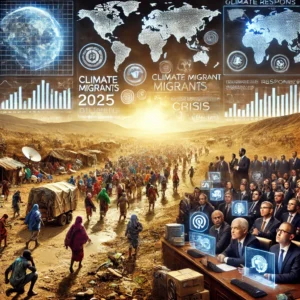
Have you ever scrolled through your social media feed and felt like the world was turning upside down—almost as if your favorite platform had transformed into a virtual rally or a full-on political protest? In 2025, that surreal vibe is no longer unusual: youth activism is taking center stage, and the digital battleground is very, very real. Welcome to an era where Gen Z and younger Millennials wield hashtags like swords, and government leaders draft urgent legislation to keep up with posts that vanish in 24 hours or get re-shared in a blink.
This unstoppable wave of socially engaged digital natives has been building for years. But now, as we push further into the mid-2020s, we witness youth-led campaigns spark policy revisions from local councils all the way to international summits. According to the Journalism, Media, and Technology Trends and Predictions 2024 by the Reuters Institute, social platforms have shifted from just being channels for entertainment to serious engines that mobilize entire communities around political and social causes. For some, that’s invigorating. For others, especially older generations who remember a time without ubiquitous tech, it’s disorienting—like jumping into a fast-moving river without a paddle. Either way, the conversation is happening, loud and unfiltered, on everything from climate policy to educational reform. And guess who’s leading the charge? The kids (or, more politely, the youth).
Below, we’ll explore how the synergy of technology and youthful drive is reshaping policy and global politics, examine shifting perspectives across generations, highlight current research and celebrity endorsements, and even glance at how corporations are recalculating their revenue strategies to align with these fiery young voices. So brace yourself, because we’re diving deep into youth activism in 2025, where social media is queen and the youth are unstoppable kings, queens, and everything in between.
Table of Contents
- When Tweets Become Ballots: A New Kind of Influence
- Government Notes on Regulating a New Frontier
- Breaking News & Political Movements Shaking 2025
- Research Labs & Scientists: Decoding the Digital Generation
- Celebrities Speak Up: When Stars Amplify Youth Voices
- Older Generations: Curiosity, Skepticism, and Hope
- Young Activists’ Perspective: Purpose, Passion, and Pixels
- Global Business & Revenue: Earning in the Age of Hashtags
- FAQs on Youth Activism in 2025
- A Slightly Jumbled Conclusion & Your Call to Action
When Tweets Become Ballots: A New Kind of Influence
The Rapid Rise of Social-Political Engagement
Over the last decade, platforms like Twitter, Instagram, TikTok, and, more recently, the new immersive VR-based social hubs have moved beyond being simple places to share memes or snapshots of dinner. Instead, they’ve evolved into robust microcosms for policy critique, social debate, and mass mobilizations. If you recall the global climate strikes in late 2019, imagine that times ten—and now it’s happening monthly or even weekly.
According to a BBC Worklife article on how Gen Z is reshaping activism, the younger crowd is more likely than older demographics to donate online, organize local protests via group messaging apps, and sign digital petitions en masse. One day, you might wake up to see a local hashtag about cleaning polluted rivers; by nightfall, it’s garnered international attention, compelling a city council to re-examine environmental policies.
It’s not all about retweets and likes, though. Many youth-led efforts move into the offline world, bridging the gap between social media posts and actual policy changes. With the introduction of micro-donation apps linked to these platforms, activists can fund everything from legal fees to grassroots campaigns at lightning speed. The era of rummaging for spare coins in your pockets is fading. Now, you just tap your phone and send support to a cause halfway around the globe.
Blurred Lines Between Online and Offline Activism
Some critics argue that online activism, often disparaged as “clicktivism,” lacks lasting impact. But multiple studies—like a Frontiers in Psychology paper from 2022—point out that digital engagement often spurs real-world action, especially among the youth. That’s not to say every hashtag ends up in legislation, but the potential for viral movements to influence policymaking has grown exponentially. Digital petitions have toppled outdated laws and, in some cases, even challenged politicians who underestimated the power of a 280-character takedown.
This interplay of on-screen activism translating into actual ballots or public protests is rewriting how we understand democracy. The youth no longer wait for a political party to announce a manifesto; they pressure officials directly, skipping the middleman and harnessing the speed of social networks to shape policy in real-time.
Government Notes on Regulating a New Frontier
Political Reactions and Legislative Tweaks
Governments, both democratic and authoritarian, are navigating precarious terrain. In many Western nations, officials scramble to draft regulations that address data privacy, misinformation, and election interference—realizing that youth activism can gather unstoppable momentum online. For example, new guidelines have surfaced in the European Union aiming to ensure “algorithmic fairness,” to prevent platforms from fueling extremist content or burying certain political perspectives.
Meanwhile, in emerging democracies, governments see digital activism as a double-edged sword. On one hand, it encourages transparency and citizen participation. On the other, it can quickly escalate into mass protests that some administrations try to quell. In a revealing instance, certain states introduced digital ID requirements for social media accounts, citing national security. Critics argue it’s a covert attempt at surveillance and censorship.
A Brief Glimpse at Policy Wonkery
Not to bog you down with legalese, but reading a sample of new media regulations can feel like stepping into a labyrinth. The language is often broad—“national interest,” “public decency”—terms that can be twisted to suit political agendas. Government spokespeople often emphasize the importance of safeguarding youth from “dangerous content,” but youth activists counter that these measures can stifle legitimate protest and free speech. And so the tug of war continues.
Moreover, some officials have recognized the unstoppable nature of youth-led online activism and are attempting a different tactic: collaboration. Public institutions in places like Germany or Denmark are forging youth advisory panels that not only consult but actively shape regulations around digital platforms. Interestingly, these efforts have garnered praise from older citizens who appreciate bridging generational divides, even if some remain skeptical that youth have the experience to tackle complex policy questions.
Breaking News & Political Movements Shaking 2025
Noteworthy Stories in the Activist Realm
- The Global Education Reform Campaign: Fueled by a wave of online petitions demanding equitable curricula and advanced digital tools for remote learning, youth activists in multiple countries pressured lawmakers to reimagine K–12 education. That synergy led to pilot programs in Finland, Nigeria, and South Korea, among others.
- Rise of “EcoTok”: This phenomenon started on TikTok but quickly spilled into mainstream media. Short videos showcasing real-time deforestation or greenhouse gas data are so potent that they’ve triggered local governments to re-evaluate environmental policies.
- Urban Housing Demonstrations: A quick look at any major city’s hashtag feed reveals the housing crisis is boiling. Young activists argue that older city councils have historically neglected affordable housing. Movements from San Francisco to Singapore are uniting under a universal cry: #Homes4Future.
It’s a wonder how quickly these political conversations amplify—local voices become global trending topics in a single day, overshadowing traditional party lines. According to a Longdom.org paper, the success of youth-led campaigns is often tied to their adept use of storytelling and emotional narratives. In short, if you can craft a compelling story that resonates with young hearts, the internet mobilizes within hours.
Research Labs & Scientists: Decoding the Digital Generation
Peeking Inside the Mind of the 2025 Activist
Why does Gen Z or Gen Alpha (those just entering teenage years) gravitate so intensely toward online activism? Research labs worldwide are attempting to answer that question with big data analytics, psychological studies, and artificial intelligence tools. For instance, a cutting-edge study from McKinsey Explainers clarifies that this generation prioritizes authenticity and social responsibility in brands, political figures, and even personal relationships. Their activism isn’t purely ideological—it’s also an expression of identity.
Scientists from ResearchGate propose that social media often magnifies existing political inclinations. So if a teen or young adult already cares about climate action, these platforms act like a turbocharger. On the other hand, those less politically inclined may still tune in due to peer influence. By the time they realize they’re knee-deep in a cause, they’ve read enough threads or engaged with enough content to formulate a stance—thus converting passive observers into active participants.
Labs, Tech, and Data Overload
Are we overloading young minds with too much data? Some experts say yes—pointing to digital fatigue and mental health strains. Others highlight how easily misinformation can spread when we rely on algorithmic feeds. That’s partly why universities and think tanks, like Frontiers in Psychology, are examining how targeted media literacy can empower youth to spot fake news and remain resilient against emotional manipulation.
Even so, the jury is still out on whether constant connectivity is detrimental. Many young activists see it as an exhilarating resource, granting them the raw materials they need to push for tangible policy reform. They do have to navigate trolls, misinformation, and sponsored ads disguised as grassroots posts, but they persist. Perhaps it’s that tenacity that truly defines them.
Celebrities Speak Up: When Stars Amplify Youth Voices
Star Power in the Digital Era
Remember the days when celebrities mostly endorsed soft drinks or sneakers? Now they’re endorsing entire social movements. In 2025, big names from Hollywood, the music industry, and international sports actively engage with youth-led campaigns. Billie Eilish, for example, once posted a two-minute clip about sea pollution that racked up millions of views and jolted local policymakers into conversation. K-pop groups have similarly harnessed their massive fandoms to support everything from mental health awareness to democratic elections—rallying an impressive global network of fans who launch or boost trending hashtags at the drop of a hat.
Meanwhile, A-list actors jump on Instagram Live with teenage activists to discuss topics like prison reform or racism in healthcare. Critics might call some of these stunts “virtue signaling,” but many young activists see them as crucial collaborations. When a star with 50 million followers endorses your cause, you get traction, funding, and media coverage that might otherwise take months—or never materialize at all.
Authenticity vs. Tokenism
Of course, not all celebrity involvement is welcomed. Some celebrities conveniently jump on a trendy cause to stay relevant, causing friction with grassroots organizations that question their sincerity. However, multiple youth-led coalitions are more than happy to partner with stars who display genuine interest. They set up guidelines ensuring any endorsement aligns with on-the-ground realities and that any funds raised go directly to grassroots efforts. According to a fundsforNGOs.org article, well-managed celebrity partnerships can drastically accelerate fundraising and awareness, so long as transparency remains a top priority.
In short, stargazing can be beneficial for activism—so long as everyone understands it’s not just about the glam of the spotlight, but about measurable progress on policy goals.
Older Generations: Curiosity, Skepticism, and Hope
Grandparents on TikTok? The Generational Divide Isn’t So Stark
Older adults often express bewilderment at the speed and scale of online activism. They recall times when you had to physically march in the street or gather signatures door-to-door, sometimes taking months or years to build momentum. So the idea of raising a million signatures in a single weekend through social media might feel surreal. Some older individuals appreciate the efficiency, but others question the depth of commitment, labeling it superficial or too ephemeral.
Nevertheless, many in the Baby Boomer or Gen X cohorts have begun adopting social platforms to engage with youth movements or to follow local politics more closely. A random anecdote from my own circle: My 65-year-old aunt recently joined a local “Green Future” activism page on Facebook—her first direct engagement with a youth-led movement. She was awed at how quickly organizers connected with elected officials, and she discovered a surprising synergy between her decades of life experience and the group’s digital prowess.
Cautious, Yet Intrigued
Government data from various countries reveals an uptick in older activists who collaborate with younger counterparts, lending wisdom while soaking up the digital toolkit. Some older people remain cautious, of course, worried about the ephemeral nature of viral trends that might overshadow more pressing issues. But ironically, these interactions are forging a new social fabric—blending generational perspectives to tackle issues spanning health care, pension reform, and climate change.
In some communities, older adults have even taken to youth-led digital training sessions, where seniors learn how to set up a secure messaging app or create an activist-friendly social media presence. It’s a touching, if sometimes awkward, bridging of the generational gap. A few might harbor reservations, but the potential for cross-generational activism is clearly on the rise.
Young Activists’ Perspective: Purpose, Passion, and Pixels
“We Don’t Have Time to Wait”
One recurring theme among young activists is a sense of urgency—whether about climate change, social justice, or educational reform. They see the inertia of traditional politics as a threat to their futures. This urgency is reflected not just in their timelines but in how they use social tools. They’ll create ephemeral stories, but also craft meticulously researched threads summarizing policy briefs, referencing peer-reviewed articles from journals like MDPI’s Sustainability, and calling out public figures who deliver empty promises.
Moreover, the Global Fund for Children’s perspective highlights that today’s youth activists are not satisfied with symbolic gestures. They insist on “receipts”—tangible outcomes that can be measured and reported. So if a politician claims to divert funds into greener energy, the youth want to see the actual budget breakdown. If corporations declare a zero-carbon pledge, activists demand third-party verification.
Intersectionality and Global Mindset
This generation’s activism is also more global and inclusive. Social media knocks down borders—someone in Brazil can mentor a climate activist in Poland, while a student in India might crowdsource funding from donors in Canada. Issues of race, gender, class, and sexuality interweave, forming broad coalitions that stand for multiple causes at once. If that sounds messy, well, it is. But it’s also vibrantly alive, something older activists might find both overwhelming and exhilarating.
In a single digital campaign, you might see a teenage climate advocate, a social justice warrior championing indigenous rights, a student nurse demanding better public health policies, and a local musician providing the anthem for the movement. They all converge, forging an ever-evolving tapestry that defies neat categorization.
Global Business & Revenue: Earning in the Age of Hashtags
Economic Transformations Amid Political Upheaval
Youth activism isn’t just a political phenomenon. It’s also reshaping corporate strategies and the broader market. When massive online campaigns succeed in pressuring companies to adopt eco-friendly practices or commit to fair labor standards, it not only prompts an internal shift but also influences revenue streams. Investors increasingly pay attention to the “ESG metrics” (Environmental, Social, and Governance), knowing that a single viral post can either elevate a brand’s reputation or bury it under a mountain of public outrage.
Recent data from corporate strategy advisors suggests that younger consumers are more likely to purchase from companies that genuinely support social causes. According to an academic paper at Oxford University Press, brand loyalty forms quickly among young demographics if they see tangible evidence of corporate responsibility. On the flip side, they’re equally quick to call out “greenwashing” or any superficial marketing that feigns social consciousness without real action behind it.
Changing the Way Businesses Engage
Some businesses have embraced philanthropic partnerships with youth-led organizations, funneling profits into scholarships, climate initiatives, or community workshops. This approach can be a public relations boon, but also a genuine investment in the future workforce. Tech companies, for instance, partner with coding bootcamps specifically aimed at underprivileged youth. Fashion retailers might highlight fair-trade supply chains to reassure conscientious shoppers.
Of course, critics argue it’s mostly about corporate self-preservation, not altruism. After all, if a brand flops among younger consumers, future earnings are at stake. Regardless of motive, the net result is that major companies are learning to speak the language of activism—incorporating hashtags in marketing, employing socially aware brand ambassadors, and occasionally forming committees with young activists to glean insights or preempt PR disasters.
FAQs on Youth Activism in 2025
1. Is today’s youth activism really more powerful than past movements?
Yes and no. Past movements were potent too, but the digital layer in 2025 amplifies actions at lightning speed, enabling cross-border solidarity in ways unimaginable before.
2. Are governments worldwide embracing youth voices or resisting them?
Both, actually. Democratic nations might adopt more open policies and advisory panels, while more authoritarian regimes clamp down with censorship. But youth movements persist across both spectrums.
3. Does social media activism lead to real policy changes or just online noise?
A bit of both. Many movements remain stuck in the online echo chamber. However, numerous campaigns—like the global climate strikes—have undeniably influenced government agendas and forced corporations to adopt new standards.
4. How do celebrities help or hinder youth activism?
Celebrities can draw massive attention and funding to movements, but risks include overshadowing grassroots efforts or diluting messages. Authentic collaboration usually yields positive outcomes, but superficial endorsements often do more harm than good.
5. Are older people involved in these digitally-driven movements?
Yes, though with varying degrees of enthusiasm. Some find it exciting and collaborative, others remain skeptical of how “serious” online activism is. However, cross-generational alliances are indeed forming, bridging the tech-savvy youth with the wisdom of experience.
6. Are businesses truly committed to supporting youth activism, or is it just PR?
It can be both. Some corporations genuinely invest in social causes and adopt ethical practices; others might engage purely for positive branding. Over time, accountability demands from youth force many companies to walk the talk.
7. What role do research labs play in shaping youth activism?
They study behaviors, analyze data on activism trends, and provide evidence-based insights that young leaders and policymakers use to refine strategies. Think of these labs as behind-the-scenes advisors, shining a light on what motivates modern activists.
8. Will youth activism keep evolving?
Absolutely. With every new platform or tech innovation, activism adapts. Given the rapid pace of change, we should expect more hybrid models—virtual protests that transform into offline rallies, and vice versa.
A Slightly Jumbled Conclusion & Your Call to Action
The future of youth activism in 2025 and beyond looks complicated, if we’re honest—partly thrilling, partly uncharted, and definitely unstoppable. We’re not just talking about a handful of viral hashtags; we’re witnessing generational demands for accountability, transparency, and transformative policies. Governments adjust their stances daily, either imposing regulations or opening new channels for youth voices. Research labs provide data-driven clarity, shining a spotlight on what triggers or sustains activism. Meanwhile, celebrities amplify causes, older folks observe with cautious curiosity, and corporations pivot their strategies—sometimes out of genuine conviction, sometimes out of self-preservation.
As you read this, a brand-new movement might be forming in someone’s living room—virtually, of course, because physical distance no longer curtails how quickly ideas spread. Or an existing campaign might be on the verge of evolving into a worldwide phenomenon. And that’s the essence of activism today: it’s fluid, it’s swift, it’s youth-led, and it demands our attention.
So, what next? If you’re intrigued or itching to make a difference, here are a few steps you can take:
- Dig Deeper: Learn how local youth activists are organizing in your region. You might be surprised at how active they are.
- Offer Resources: Whether financial, technical, or simply emotional support, your contribution can boost a movement’s reach.
- Collaborate: If you’re older, consider becoming a mentor or ally. If you’re younger, invite parents, teachers, or grandparents to see your world online.
- Stay Critical: Question everything, from brand endorsements to celebrity shout-outs. Authentic activism thrives on transparency.
In the end, 2025 might just be a pit stop on an even longer road to sustainable, inclusive global change. Each tweet, post, or share might be shaping tomorrow’s history books. Or maybe it’s just shaping a local community’s reality. Either way, it’s happening now, and you can be part of it—no matter your age, background, or geographic location.
External Links
- External Links:
- Journalism, Media, and Technology Trends 2024, Reuters Institute
- BBC on Gen Z Activism
- Frontiers in Psychology Study
- Longdom.org on Youth Political Activism
- McKinsey Explainers on Gen Z
- MDPI’s Sustainability Journal
- FundsforNGOs.org Youth Activism Insight
- Global Fund for Children on Modern-Day Youth Activism
- Oxford University Press Book Chapter
- ResearchGate on Social Media & Political Engagement





